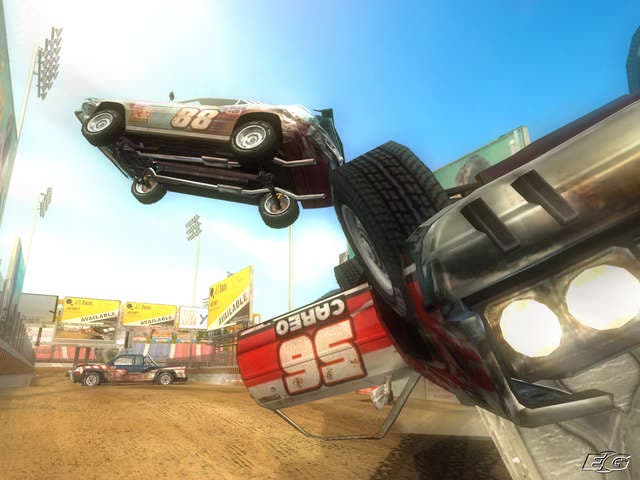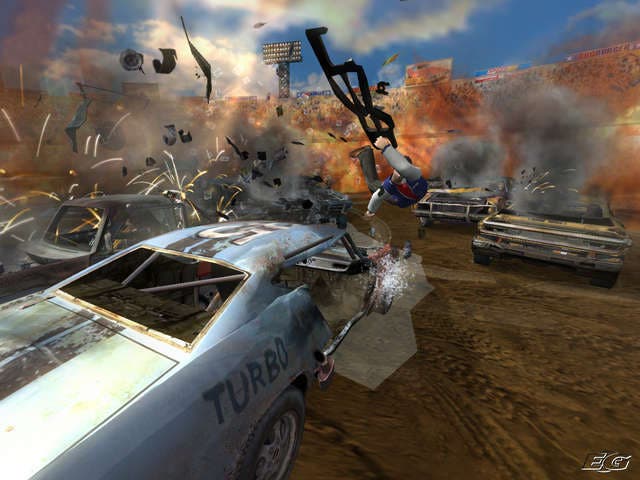FlatOut 2
Clunk click, every trip.
Often the best ideas - or, at the very least, the most fun ideas - come from doing things wrong. How many people playing Turbo Esprit on the Spectrum actually bothered chasing down purple drug cars? And how many hurtled around the city, knocking stick men off ladders? Why did everybody with an Amiga own a copy of Indy 500? Was it for the lifelike recreation of the world's most tedious motorsport, or was it because you could drive backwards around the track and watch the ensuing pile up in slow motion replay?
From Destruction Derby to Driver to Burnout, some of the most indecently entertaining car games of recent(ish) years have succeeded by encouraging gamers to do what's fun rather than what has always been deemed "right". In other words, smashing the ever-loving crap out of everyone else.
With this in mind, the original FlatOut is a curious beast. Released less than twelve months ago, it garnered good-to-glowing reviews (not least from this very website - "a hair's breadth from being legendary" howled Pat Garratt) and has since clocked up over 800,000 sales worldwide. But it's been a rather quiet sort of success, not really making an appreciable impact on the hive mind of the gaming public, the obvious merits of the game predictably overshadowed by the marketing hurricane unleashed by EA to promote its glossy Burnout sequels.
Flat Eric
It doesn't help that FlatOut was sold almost entirely on the basis of its admittedly hilarious rag doll physics system, and the small yet ingenious notion of having a driver who constantly forgets to buckle up. Being able to catapult your virtual self through the windscreen made for an eye-catching gimmick, but did rather sell the game itself a tad short. Perhaps wisely, the rag doll stuff is toned down this time and restricted mostly to the mini-games, where the amusement actually complements the gameplay rather than interrupting it.

For this second spin around the stock car track, Finnish developer Bugbear has opted for the spit and polish approach rather than any major overhaul. The physics, the game modes and the sheer range of options have all been significantly improved. Without going too cut-and-paste happy with the press release, there are now twice as many tracks (60), twice as many cars (34), twice as many mini-games and destruction arenas (18) and thousands more trackside elements to smash into splinters with your speeding engine of death.
The stats are impressive, but despite the obvious effort that has gone into expanding the overall experience, most of the complaints from the first time around haven't been addressed. The handling is still loose and flappy, meaning that every powerslide or jump holds the potential to end in an uncontrollable skid or crash. This rubbery feel can be overcome, but it's less a case of mastering the control system and more a case of figuring out how to compensate for its shortcomings. Even when you've allowed for the spongy steering, when it really counts you still never feel completely in control.
Super, Smashing, Great

The wild physics system can still be a hindrance as much as a source of amusement as well. Pretty much everything can be shunted or shattered with your car, and the debris remains to litter the track throughout the race in a satisfying way. However, the physics of the game - which nestle in that sweet spot between impressive reality and fantastic exaggeration 99 per cent of the time - can also mean that your car can be fatally knocked off course, or spun out of control entirely, by a can of paint, a broken plank or an old tyre.
There's no denying that FlatOut's more open track layouts are vastly preferable to the invisible walls and smooth edges of Burnout (hell, my 4-year-old son can steam around Burnout time trials just by holding down the accelerator and letting the game guide him around the corners) but there's a frustrating inconsistency to the way obstacles are treated. On one track, hefty logs or metal pipes can be strewn across the course and rammed out of the way, on another, they form an impassable obstacle. One minute you'll be whooping with joy at the mayhem being unleashed, the next minute you'll be cursing as you're forced to yet again slowly reverse back onto the track after being stopped dead by something you thought you could smash past.
I should probably take time to mention that there's also the obligatory inconsistent soundtrack which largely features gravel-voiced American rockers [though Supergrass are on it, which is a big plus - Ed], which does at least suit the backwoods stock car vibe of the game, but still begs to be switched off after only a few races. The decision to include yelping tosspots Nickelback is reason enough to make custom soundtracks an essential feature in this sort of game.
Pull up to my bumper

The good news is that the AI racers are just as likely to screw up as you, and it's not uncommon to bounce from pole position to back of the pack and up again in the course of one lap. The career mode has been loosened up a little as well, meaning there are now more choices as you progress through the championships - and the ability to save more than one car in your garage is a definite bonus, especially as compacts, sports cars and trucks have been added to the generic muscle cars of old. There are also more ways to play online, which makes sense as this is a game that benefits from flesh and blood opponents. Wherever FlatOut felt truncated or frustratingly small, this sequel offers an embarrassment of riches - while you may eventually grow tired of the endless vehicular destruction, it'll take a lot longer to run out of exciting ways to do it.
The mini-games are even sillier than ever, with the six new additions making the task of firing your driver as high up into the air as possible seem positively vanilla-flavoured. Taking full advantage of the flailing rag doll graphics, events such as Stone Skipping take the basic concept into fun new realms, while trying to hit giant playing cards to form a winning poker hand brings a greater sense of strategy into what could easily be a braindead diversion. The destruction arenas still call to mind the shredded metal carnage of Psygnosis' PSone franchise, and while it's a bold driver who can actually be the last car, er, standing, it's more about catharsis than competition. The decision to set one arena on the roof of a skyscraper and not let you fall off is a heinous oversight though. Taken together, this sadistically inventive combination of driver torture and rampant road ragery now makes for a far more entertaining winner-stays-on communal gaming experience than Burnout's Crash Mode and is a compelling side dish to the main event.
So, yes, you could argue that this is essentially just the first game re-released with new tracks, tweaked visuals and a massive wodge of extra stuff to play with. It's not far from the truth, though it's a perfectly legitimate approach - especially when the first game was hardly in need of sweeping changes. Still, it's undeniably annoying that key gameplay complaints from last time remain unaddressed, and fans of the original may find themselves feeling that this is merely the game they should have been given first time around. Despite being a superior game in several crucial areas, FlatOut 2 seems content to cement itself in the niche of Burnout's bratty redneck cousin, but it passes at least one basic quality test with flying colours: I couldn't help taking regular breaks during this review to creep back to the joypad for another go. That alone makes it worth a recommendation in my book.







